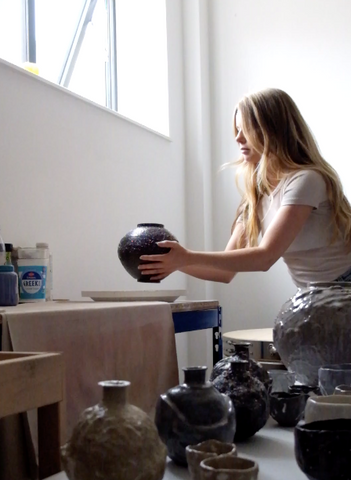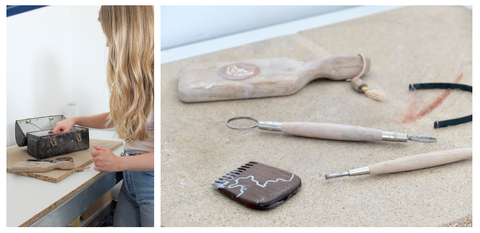The team at Maud & Mabel interviews ceramicist Annette Lindenberg on 14th October 2022 in her London studio.
London-based ceramicist Annette Lindenberg speaks to us about the inspirations behind her works, her love story with the techniques of kurinuki, and connection to Japanese wabi-sabi philosophy. She shares with us the solace she finds in seeking perfection in imperfections, a quality embodied in her works. Her kurinuki pieces are at once rough and soft, rugged and delicate. There is a soothing and peaceful balance between these dichotomies in her works which capture a delicate intimacy.
Revisiting memories and anecdotes from her daily life and her childhood, when she had already developed an interest in making things and playing with various materials, Annette recounts how these stories are built into her artworks. The relationship between artist and clay is intricately intertwined. While Annette’s personal moments are reflected, consciously and subconsciously, in her creative practice, her physical presence is retained by the clay during the firing process — a result of its material memory.

M&M: What inspires your work?
AL: When I go out for a walk, I see things out and about that maybe have tones I like. I go to museums a lot, which really help me. Some of my pieces are inspired by Egyptian diorite, for example – big carved stone jars. And then I take things with me sometimes: I make my pale blue glaze using things from my mom’s garden.
I know it’s a classic thing to say I’m inspired by the environment, but I really am; in particular, stones and the way I feel in different spaces and places. The reason I’m so drawn to the silver droplets is because it really reminds me of visiting my grandmother in the Canary islands and lying on top of her roof, getting to look at the stars because it’s so bright and sparkly. It gives me a calming feeling to think about that memory. I revisit memories and moments I enjoyed and bring those into my work.

M&M: How and when did you decide to become a ceramist? What was that journey like for you?
AL: I feel like I accidentally became a ceramicist. I always thought I would go down more of an academic route and maybe become a psychologist. Then my grandmother signed me up to open day at Cardiff Met, without telling me, to have a look at their art department; she told me, “you should just have a look at it and see what you think.” We went and I instantly fell in love with a particular multidisciplinary course, because I knew that I loved all different types of materials and wanted to experiment with everything. So I then did everything I could to get into that course.
I was having a really stressful time in my life when I started doing clay, or ceramics, as a way of relaxing I guess. I tried out throwing and different ways of handbuilding, and it just didn’t sit right with me. When I came across kurinuki, it was like everything had changed. I realised not everything has to be perfect and round. There’s something really nice and meditative about the process, and I guess it was, partly, a way of making myself feel more relaxed. Then it just went off from there. I sold out my degree show in about three days and had to remake everything, and it just got rolling.

M&M: Does your family and background impact your practice?
AL: I don’t know whether I would say my family has had a big impact. When I was a child I got left to do my own things quite a lot. Because of that, I got really into making things myself and playing around with different materials since I was quite little. I made a life-sized horse out of cardboard when I was seven because I wasn’t allowed to have a real horse – obviously, we were in Vienna. I remember I rolled all of the cardboard so that it was a horse that you could sit on. I was determined that things I made were not just an image of the thing, but rather they either had a purpose or were technical in some way.
M&M: Does functionality weigh in your creative process?
AL: It used to, but I think over time that has changed quite a bit. I’ve let go of some functionality to find more of the things I really like. I think sometimes if you’re really focused on something being functional, you can discard objects that have a lot of beauty to them. Let’s say, if you take an object that’s been cracked, in the west, we might just throw that away; whereas in Japanese culture, you might use kintsugi to repair it and it becomes a more beautiful object. I like this idea that an object can, in some cases, appear functional. You can look at some of my pieces and they can appear like a functional object, but in reality, they may be meant for decoration. It’s the thought of the object rather than the being that object.

M&M: How did you come across the Japanese aesthetic values and methods of making that you refer to and how does it formulate into your practice?
AL: I was going through a stressful time right at the beginning of my bachelor degree at the end of my foundation course, and I was doing a lot of research for my studies anyway. I just really connected with the Japanese design ideology of wabi-sabi, which I think many people feel a connection to: this idea that something doesn’t need to be completely perfect, and actually imperfection kind of gives it humanness, or, soul. I really feel quite connected to the whole Japanese way of thinking and making, and the fact that they really respect craft, in a really different way from here.
M&M: In your own writing, you mention the intimate connection between a maker and clay, and that the material is sensitive to its maker. Can you explain this connection?
AL: Clay (depending on the clay you are using) has a lot of material memory, so it will revert back to something you did to it. If you hold the clay in a certain way while you are making it, it can end up warping and changing back to that later on in the firing process.
When I started playing around with porcelain, I felt a connection to the clay. I was interested in this at the time because I had a whole batch of tea bowls come out that fitted perfectly into my hand. They had a little indent from where my hand was, even though I had gotten rid of that while I was making it. I realised that clay can mimic or mirror you in some way, shape or form. That was the initial spark that made me realise it is all about that relationship between me and the clay. And because I’m not throwing on the wheel, which automatically spins around and makes something round for me, I have to find that roundness in the block.

M&M: Can you tell us a bit more about your work?
AL: The things I make are often made with the intention to change. If something has a proper crackle on it and you were using it, over time it will begin to get a worn effect. I think there’s something really beautiful about things that are old and used, and I always come back to this. We’re very quick to discard things, especially nowadays. We just throw everything away if we don’t like it anymore, whether it’s because it has a stain or it’s not exactly how it was when we bought it. And yet, if you were to keep some of those things, over time they gain in value again and become these beautiful precious objects that other people will look back on to feel transported into a time.
When I go to a museum, the objects I look at may have been, at one point, thrown away by someone because they had a crack in them, or weren’t useful anymore, or had stains on them. But now that they are behind glass and presented beautifully, we look at them as beautiful objects because it’s a museum piece.
I really like the idea that when things are at this state [referring to the works in her studio], they are the most perfectly imperfect as they will ever be. Over time, things will change. Little bits of dirt will get stuck in there, and maybe that is exactly how it’s meant to go. Maybe that is the life of that pot.

Annette Lindernberg is a German/British ceramicist based in London. Annette holds an MA in Ceramics and Glass from the Royal Academy of Art (2021) and a BA in Artist: Designer Maker from Cardiff Metropolitan University. Her works have been exhibited at the British Art Fair at Saatchi Gallery, the London Art Fair with Modern Clay, and Collect 2022 with Maud and Mabel.
